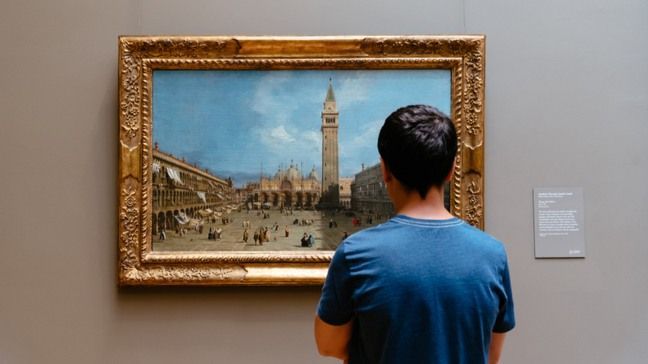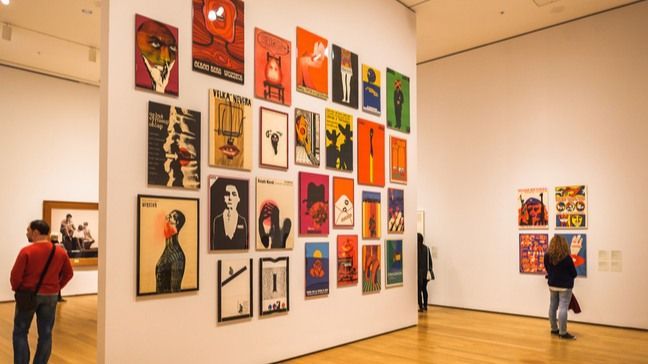Whi Investor Are Investing So High in Paintings and Art
Investing in art may be a swell idea if it's something you lot truly honey. Just it tin can exist risky, then you need to do your research.
Art tin do more than burnish a living infinite. The art market has become one of the hottest new investment crazes in recent years. Painting and sculpture collectors frequently buy pieces with an eye towards adding to their investment portfolio.
But volition fine art investment really earn you a profit? Or is this new nugget class mostly hype?
How do fine art investments work?
Like stocks and bonds, art tin increment in value. If an up-and-coming artist goes on to a successful career, the greenbacks value of their work will skyrocket. An Fine art Basel annual report estimates global fine art market place sales reached over $67 billion in 2018.
Art is a long-term investment
Profits from art won't happen overnight. Experts recommend art investment for patient investors with a time window of ten years or more, so recollect long term.
Many art investors include paintings in their manor planning as assets to laissez passer on to their descendants.
The art market place follows rules of its own
One major perk of fine art as an asset is that its value doesn't rise or turn down with the stock market. Even if your stocks aren't performing well, your fine art investment may exist doing cracking—practiced news for the savvy investor who wants to diversify a portfolio and minimize risk. And ideally, though not ever, art volition keep affectionate in value over time.
Art is risky
Every artwork is unique, and the art market has ups and downs simply like any other market.
Since information technology's incommunicable to determine an artwork's true value—a lot depends on the artist'south reputation and on the economic system as a whole—y'all should be comfortable bold some hazard.
How to invest in art
Outset by deciding how much money you're prepared to spend. It should be an amount you lot tin beget to office with in case the artwork depreciates. Don't forget to factor in possible storage and maintenance costs.
Then learn equally much nigh the art world every bit you lot can. Visit local galleries and see what they have to offer; chat with curators, who will usually exist eager to answer any of your questions.
If y'all live in or well-nigh a urban center, you're probably close to gallery openings and art fairs, where up-and-coming artists tend to showcase their pieces.
Browse sites like Artnet and online sale houses like Sotheby's to get a sense of how the market works.
Once a piece or creative person catches your eye, you can start narrowing down your enquiry to meet how much a particular artwork costs. The app Magnus provides upwardly-to-date pricing information for potential investors – accept a photo of the artwork and they'll tell you the details. Your next step is to get the artwork appraised by a professional person appraiser to determine its quality.
You can either purchase an artwork yourself – ofttimes the costlier option – or buy shares in artwork through an online market.
Since this is the information age, plenty of loftier-end artwork sells online. But before you buy over the Internet, make sure yous're purchasing from a legitimate gallery, dealer, or investment firm.
Masterworks

Masterworks is a great option, specially for the novice fine art investor because they do most of the work for you. Masterworks buy paintings and sell shares to investors, keeping you updated on the investment equally information technology progresses.
With Masterworks y'all don't really ain or shop the artwork. Instead, you lot and several other investors purchase shares in high-value works vetted by experts for authenticity. Masterworks does non have specific minimum investment amounts; minimums vary depending on the specific investment offerings available at the time you're investing.
Similar marketplaces include Maecenas (where you tin can buy shares in paintings) and Saatchi Art (where yous can browse and purchase direct online).
Encounter IMPORTANT INFORMATION HERE
What to know before investing in art
It should only be a minor role of your portfolio
For most people fine art will be only a small fraction of a well-rounded investment portfolio. You may profit, just you're highly unlikely to get a huge payout from fine art alone.
Think of information technology like a real estate investment; extra, not essential. Don't rely on an art investment for steady income. And don't forget you'll exist paying taxes on any gains, since the IRS considers art a collectible.
Fine art is non-liquid
It's important to call back art is a not-liquid or illiquid asset. This means it'south difficult to convert into cash right abroad.
Liquid assets, like stocks, bonds, and savings accounts, can produce cash more than easily. Illiquid avails, like real estate and art, take much longer to sell even if they have great budgetary value.
Though information technology's possible to sell your fine art, near investors don't. An auction house, your best bet for selling, oft charges hefty fees. Since art prices fluctuate regularly there are no guarantees selling volition earn y'all a turn a profit.
When should you invest in art?
Here are some signs the reward might outweigh the risk.
You enjoy art

Most art investors start out as collectors. If you love going to galleries and you're already on the spotter for a great piece to add together to your home, turn that appreciation into an asset! But if y'all don't like art for its own sake, other investment options volition serve you lot better.
You don't accept to be a collector to outset investing in art. You can keep your investments to only one or two pieces. But knowledge of the art globe—or working with someone who has this knowledge—is key if you lot want to pick winners.
Earnings would exist great, simply you're not counting on them
The all-time approach to art investment? Consider the artful pleasure first and the financial benefits second.
Welcome any profits, just don't programme your financial futurity around receiving those profits. Any coin earmarked for retirement, for case, should go into other assets. In fact, 1 Stanford study says art is unlikely to ameliorate whatsoever portfolio. Lesser line: don't invest anything in art you can't afford to lose.
You're willing to research
That said, art investors can pick pieces with great long-term value. But enter informed, only every bit you would be if you invested in the stock market.
Offset past researching the creative person of the piece of work you're because. Ask the following questions:
- Are their pieces included in any museums or famous collections?
- Have they won awards or gained other recognition for their work?
While upwardly-and-coming artists can be exciting, their reputations may or may not final. And this will impact the value of their piece.
You can afford the maintenance
Fine art investors get to control their avails, which can exist a bonus. But y'all're responsible for keeping the artwork in pristine condition, which means monitoring factors similar humidity and sunlight.
If you display the artwork you'll take to make sure information technology maintains its original quality. If you put it in storage you'll pay for that as well. Add insurance costs and the price of an authenticity certificate, and your maintenance beak adds upward.
What to expect for when buying fine art
The art world is broad, then to narrow down your search, pick a genre or time menstruation that interests you. Then discover an expert to help y'all wait.
Nosotros recommend working with an fine art advisor or an investment company specializing in art (we've listed some options below.)
Having someone in your corner helps when information technology comes time to determine the fair market value of an art piece, making sure y'all get your money's worth.
Once you've found your area of focus, know what kind of piece you're buying.
- Originals or ane-of-a-kind works of art come with the highest toll but the greatest potential payoff.
- Prints or copies are more affordable just less likely to turn a turn a profit. The best quality print is known equally a giclée (zhee-klay). It's similar to the original work than other prints, merely also more expensive. As a rule, rarer prints are more valuable. One print from a small-scale number of limited editions volition accept more than value than a print with many copies floating around.
- Reproductions are mass-produced copies without a express run. They're the near affordable option, but they're as well worth the least. You probably won't meet any turn a profit from a reproduction.
No matter what, look for quality and good condition. Especially for pricey investments, it's worth spending the actress cash to get an appraisement.
Where to look for fine art
Galleries, museums, auction houses

Museums and galleries, of course, are bang-up options. Research whatsoever galleries beforehand to acquire as much as y'all can.
Auction houses where you can bid on art are a more intense surround, simply yous tin score a masterpiece if yous're lucky. Exist aware auction houses oft charge a buyer'southward premium in addition to the sticker price.
Is fine art a proficient investment?
At the finish of the day, this question really depends on your personal investment goals.
If you desire guaranteed returns on the money you invest, or if you don't have much money to work with, you're probably safer skipping the art houses and sticking to liquid assets. Make new investors should likewise give their portfolio plenty of time to mature earlier taking the leap.
Merely for seasoned, confident investors who are enthusiastic about fine art—and who take extra funds to cover the costs—an investment in a painting or sculpture can be an exciting fashion to diversify a portfolio.
Summary
With an eye for art and a willingness to take a little take a chance, a new or experienced investor can find art investment incredibly rewarding. Though it should only be part of your overall portfolio, art can round out other investments nicely.
Read more
- Best Investment Accounts For Young Investors
- How To Invest: The Smart Way To Make Your Coin Abound
Related Tools
Save Your Kickoff - Or Adjacent - $100,000
Sign Upward for free weekly money tips to help you lot earn and salvage more
We commit to never sharing or selling your personal data.
Source: https://www.moneyunder30.com/how-to-invest-in-art